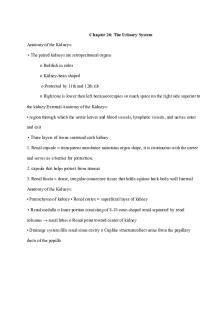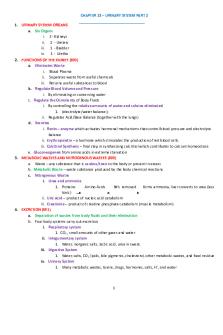Ap2 ex 26 urinary system PDF

| Title | Ap2 ex 26 urinary system |
|---|---|
| Course | Anatomy And Physiology II |
| Institution | University of West Florida |
| Pages | 5 |
| File Size | 357.1 KB |
| File Type | |
| Total Downloads | 33 |
| Total Views | 176 |
Summary
Exercise involving the urinary system for anatomy and physiology II....
Description
Anatomy and Physiology II Lab Handout Exercise 26 Anatomy of the Urinary System, Lab Manual 331-37 You will be using the lab manual and this website to complete this lab: Begin by watching this short video on the kidney structure: https://www.youtube.com/watch?v=H2VkW9L5QSU 1. Describe the overall function of the urinary system and locate these parts using lab manual figure 26.1: R/L Kidney: removes nitrogenous waste from the body, as well as maintain electrolytes, acid-base, and fluid balances of the blood. Bladder: Storage area for urine R/L renal artery: supply the kidney with blood Ureter: drains urine from the kidneys R/L renal vein: drains the kidneys of oxygen poor blood Urethra: drains the bladder
2. Describe the structural differences in the male and female urinary systems. Male urinary systems are also connected to their reproductive system and function. Male urethras have dual function, disposing of urine from the bladder, as well as provides a passageway for semen to eject from the body. Male urethras are also longer than female urethras. Female urinary systems only serve to dispose of urine and their urethras are much shorter than male urethras, making them more vulnerable to UTIs. Explain the difference between these 3 kidney processes: Filtration: the process in which the glomerulus filters the blood and takes out anything considered waste like toxins and metabolic waste Reabsorption: this process refers to the reabsorption of nutrients filters through the glomerulus, like amino acids or water Secretion: refers to the formation of urine that is them transported to the bladder and then disposed of Use these websites to learn this info. http://www.interactivebiology.com/3732/nephron-the-functioning-unit-of-the-kidney/ and http://www.interactive-biology.com/3816/nephrons-function-of-the-varioussegments-of-the-renal-tubule/ 3. Using figure 26.3 of the manual to be able to identify these kidney parts:
Renal capsule renal pelvis renal cortex renal medulla renal column renal pyramid
ureter major calyx minor calyx papilla renal artery renal vein
4. Trace the blood supply of the kidney from the renal artery to the renal vein by relisting these vessels in the correct order. Use figure 26.3b and this website to view and learn the kidney blood vessels: https://www.youtube.com/watch?v=OsJMh7nTLlo Renal Artery, Interlobar Artery, Arcuate Artery, Cortical Radiate Artery, Arcuate veins, interlobar veins, renal veins 5. Using the parts listed in questions 1, 3 & 4 label the following kidney picture. Use the website images and the book figures to assist you in the activity.
1. Renal Pyramid in renal medulla 2. Cortical Radiate artery 3. Renal Artery 4. Renal Vein 5. Renal Hilum 6. Renal Pelvis 7. Ureter 8. Minor Calyx 9. Renal Cortex 10. Fibrous Capsule
11. Fibrous Capsule 12. Cortical Radiate veins 13. Renal Cortex 14. Renal Column 15. Major Calyx 16. Papilla of pyramid 17. Renal Column
6. Label the anatomy of the nephron using figure 26.4b of manual Nephron Parts Label this picture with these terms: proximal convoluted tubule, collecting duct, glomerulus, distal convoluted tubule, afferent arteriole, efferent arteriole, loop of Henli, Bowman’s Capsule, peritubular capillaries
1. 2. 3. 4. 5. 6. 7. 8. 9.
Glomerular Capsule Glomerulus Afferent arterioles Efferent arterioles Peritubular capillaries Distal Convoluted Tubule Collecting Duct Nephron loop Cortical Radiate vein
7. On this picture label the filtration, secretion and reabsorption areas. Use figure 4.7 on the website to help you with this labeling. Filtration: 1, 2, 3 Secretion: 6, 7, 9 Reabsorption: 4, 5, 8 8. Urinalysis Use the powerpoint file entitled Virtual Urinalysis Lab found in the Canvas assignment section for this module. After it opens, click on F5 to activate
the online version of the lab. Go thru the overview, macroscopic and chemstix sections, fill in these data charts and answer these 7 lab questions.
9. Virtual Urinalysis Lab Questions Answer these from the blackboard 1) What metabolic by-product from hemoglobin colors the urine yellow? Urochrome 2) How can adequately water intake be judged by the color of urine? The more diluted the color, the more adequately your water intake is. 3) What is hematuria? Bleeding in the urinary tract 4) What is the normal value for glucose in the urine? None 5) What is ketonuria? The accumulation of ketone bodies; diet consisting of low carbs, starvation, or uncontrolled diabetes 6) Elevated levels of white blood cells produce what condition in urine? Pyuria 7) What cells would be found in urine that originate in the urethra or bladder? Uric acid...
Similar Free PDFs

Ap2 ex 26 urinary system
- 5 Pages

Chapter 26 Urinary System
- 20 Pages

Chapter 26 The Urinary System
- 8 Pages

Chapter 26 The Urinary System 7
- 3 Pages

Urinary System
- 17 Pages

Urinary system Summary
- 6 Pages

Urinary System Lecture Notes
- 15 Pages

Urinary System Review
- 3 Pages

Nephrology: Urinary System
- 5 Pages

Chapter 25 urinary system
- 16 Pages

Urinary system studoc
- 8 Pages

Urinary System Lecture
- 3 Pages

Urinary System Definitions
- 3 Pages

Chapter 11 Urinary System
- 9 Pages

Chapter 15 The Urinary System
- 6 Pages
Popular Institutions
- Tinajero National High School - Annex
- Politeknik Caltex Riau
- Yokohama City University
- SGT University
- University of Al-Qadisiyah
- Divine Word College of Vigan
- Techniek College Rotterdam
- Universidade de Santiago
- Universiti Teknologi MARA Cawangan Johor Kampus Pasir Gudang
- Poltekkes Kemenkes Yogyakarta
- Baguio City National High School
- Colegio san marcos
- preparatoria uno
- Centro de Bachillerato Tecnológico Industrial y de Servicios No. 107
- Dalian Maritime University
- Quang Trung Secondary School
- Colegio Tecnológico en Informática
- Corporación Regional de Educación Superior
- Grupo CEDVA
- Dar Al Uloom University
- Centro de Estudios Preuniversitarios de la Universidad Nacional de Ingeniería
- 上智大学
- Aakash International School, Nuna Majara
- San Felipe Neri Catholic School
- Kang Chiao International School - New Taipei City
- Misamis Occidental National High School
- Institución Educativa Escuela Normal Juan Ladrilleros
- Kolehiyo ng Pantukan
- Batanes State College
- Instituto Continental
- Sekolah Menengah Kejuruan Kesehatan Kaltara (Tarakan)
- Colegio de La Inmaculada Concepcion - Cebu
